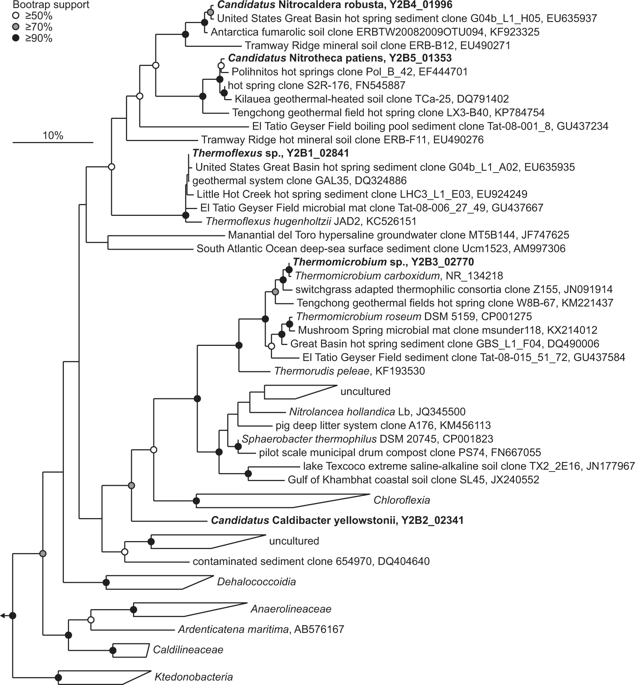Our official English website, www.x-mol.net, welcomes your
feedback! (Note: you will need to create a separate account there.)
Extremophilic nitrite-oxidizing Chloroflexi from Yellowstone hot springs.
The ISME Journal ( IF 10.8 ) Pub Date : 2019-10-17 , DOI: 10.1038/s41396-019-0530-9 Eva Spieck 1 , Michael Spohn 2 , Katja Wendt 1 , Eberhard Bock 1 , Jessup Shively 3 , Jeroen Frank 4, 5 , Daniela Indenbirken 2 , Malik Alawi 6 , Sebastian Lücker 4 , Jennifer Hüpeden 1
The ISME Journal ( IF 10.8 ) Pub Date : 2019-10-17 , DOI: 10.1038/s41396-019-0530-9 Eva Spieck 1 , Michael Spohn 2 , Katja Wendt 1 , Eberhard Bock 1 , Jessup Shively 3 , Jeroen Frank 4, 5 , Daniela Indenbirken 2 , Malik Alawi 6 , Sebastian Lücker 4 , Jennifer Hüpeden 1
Affiliation

|
Nitrifying microorganisms occur across a wide temperature range from 4 to 84 °C and previous studies in geothermal systems revealed their activity under extreme conditions. Archaea were detected to be responsible for the first step of nitrification, but it is still a challenging issue to clarify the identity of heat-tolerant nitrite oxidizers. In a long-term cultivation approach, we inoculated mineral media containing ammonium and nitrite as substrates with biofilms and sediments of two hot springs in Yellowstone National Park (USA). The nitrifying consortia obtained at 70 °C consisted mostly of novel Chloroflexi as revealed by metagenomic sequencing. Among these, two deep-branching novel Chloroflexi were identified as putative nitrite-oxidizing bacteria (NOB) by the presence of nitrite oxidoreductase encoding genes in their genomes. Stoichiometric oxidation of nitrite to nitrate occurred under lithoautotrophic conditions, but was stimulated by organic matter. Both NOB candidates survived long periods of starvation and the more abundant one formed miniaturized cells and was heat resistant. This detection of novel thermophilic NOB exemplifies our still incomplete knowledge of nitrification, and indicates that nitrite oxidation might be an ancient and wide-spread form of energy conservation.
中文翻译:

来自黄石温泉的嗜极亚硝酸盐氧化 Chloroflexi。
硝化微生物在 4 至 84 °C 的宽温度范围内发生,之前对地热系统的研究揭示了它们在极端条件下的活动。古细菌被发现负责硝化的第一步,但澄清耐热亚硝酸盐氧化剂的身份仍然是一个具有挑战性的问题。在长期培养方法中,我们将含有铵和亚硝酸盐的矿物介质作为底物与黄石国家公园(美国)两个温泉的生物膜和沉积物接种。宏基因组测序显示,70°C 下获得的硝化菌群主要由新型 Chloroflexi 组成。其中,两种深分支的新型 Chloroflexi 因基因组中存在亚硝酸盐氧化还原酶编码基因而被鉴定为假定的亚硝酸盐氧化细菌(NOB)。亚硝酸盐到硝酸盐的化学计量氧化发生在岩石自养条件下,但受到有机物的刺激。两种 NOB 候选者都能在长时间的饥饿中存活下来,而数量较多的一种则形成微型细胞并且具有耐热性。这种新型嗜热 NOB 的检测证明了我们对硝化作用的了解仍然不完整,并表明亚硝酸盐氧化可能是一种古老且广泛传播的能量守恒形式。
更新日期:2019-10-17
中文翻译:

来自黄石温泉的嗜极亚硝酸盐氧化 Chloroflexi。
硝化微生物在 4 至 84 °C 的宽温度范围内发生,之前对地热系统的研究揭示了它们在极端条件下的活动。古细菌被发现负责硝化的第一步,但澄清耐热亚硝酸盐氧化剂的身份仍然是一个具有挑战性的问题。在长期培养方法中,我们将含有铵和亚硝酸盐的矿物介质作为底物与黄石国家公园(美国)两个温泉的生物膜和沉积物接种。宏基因组测序显示,70°C 下获得的硝化菌群主要由新型 Chloroflexi 组成。其中,两种深分支的新型 Chloroflexi 因基因组中存在亚硝酸盐氧化还原酶编码基因而被鉴定为假定的亚硝酸盐氧化细菌(NOB)。亚硝酸盐到硝酸盐的化学计量氧化发生在岩石自养条件下,但受到有机物的刺激。两种 NOB 候选者都能在长时间的饥饿中存活下来,而数量较多的一种则形成微型细胞并且具有耐热性。这种新型嗜热 NOB 的检测证明了我们对硝化作用的了解仍然不完整,并表明亚硝酸盐氧化可能是一种古老且广泛传播的能量守恒形式。





















































 京公网安备 11010802027423号
京公网安备 11010802027423号